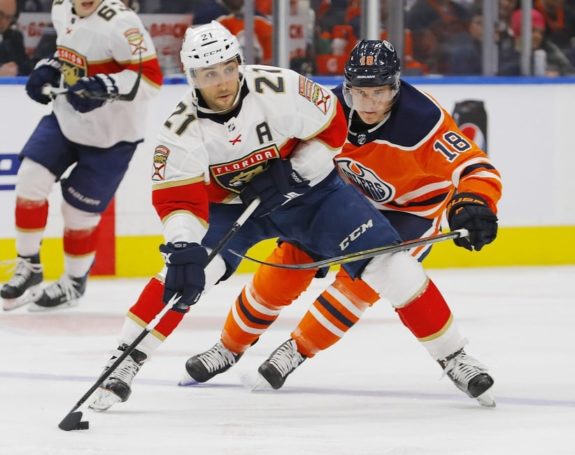Throughout the preseason, the Florida Panthers continued to roll out the same top two offensive line combinations, leading to strong assumptions that these two lines will be the same to start the season. Newly-appointed captain Aleksander Barkov has been centering the first line with Nick Bjugstad and Evgeni Dadonov on the wings. Vincent Trocheck on line two, meanwhile, has served as the pivot for Jonathan Huberdeau and newly acquired sniper, Mike Hoffman.
These line combinations were nearly identical to the ones the Panthers went with in the latter half of last season. The only exception being Hoffman, who was not on the team until a trade with the Ottawa Senators earlier in the offseason. If the lines remain the same to start the season, we will see Barkov lined up with the team’s third and, arguably, fourth-best wingers. It may seem peculiar to have the best center on the team not playing with at least one of, if not two of their best wingers, but Barkov is unlike most centers.

The 23-year-old has established himself as a legitimate first-line center, possessing the rare combination of high offensive production and elite defensive proficiency. Proven capable of generating offense with any wingers he is lined up with, his unique skill set affords the Panthers coaching staff the ability to spread out scoring to other lines, giving the team options for line combinations. This ability may become a key factor for success in the 2018-19 season.
Barkov Finds Success With All Linemates
Over the last three seasons, Barkov has hit his stride offensively. In 2015-16, he totaled 59 points in 66 games, including 28 goals. He followed that up with 52 points in 61 games in 2016-17 while missing a quarter of the season due to a lower-body injury. Last year, he exploded offensively as he reached career highs of 51 assists and 78 points and fell one goal shy of tying his career high in that category.
Although totals of 59 and 52 points do not jump off the page, take into account the points-per-game of .89 and .85, respectively. Had Barkov played all 82 games those years, his totals would have rocketed to nearly 73 and 70. Those numbers would have placed him in the top-20 of point totals in the league each season.
Most impressively, Barkov accomplished these totals with a host of different wingers. The three primary linemate combinations for him those seasons were Huberdeau and Jaromir Jagr, Huberdeau and Dadonov, and Dadonov and Bjugstad. Barkov did spend time at one point or another with several more, but to a lesser degree.
The most common of Barkov’s wingers were Huberdeau and Jagr. This line was successful in generating scoring chances in a number of ways. Huberdeau and Barkov created offense through high-end speed and playmaking. Jagr, meanwhile, complimented their strengths with puck protecting skills and a high hockey IQ, which helped cycle the puck around the boards to linemates to keep the defense pinned in their zone.

Barkov’s next rendition of linemates came in the form of Huberdeau and Dadonov during the first half of the 2017-18 season. Dadonov came to the Panthers after several seasons in the KHL. It was his second stint in the NHL after failing to make an impact years prior with the Panthers.
With Dadonov at the wing instead of Jagr, the line’s speed increased dramatically, which made the line more lethal. In fact, for the better part of two months, the Panthers first line was one of the best lines in hockey. In nearly every game the line put up at least two points, with each player playing at nearly a point-per-game pace. Unfortunately, the rest of the team failed to produce, and though the line was one of the best in the league, the team was one of the worst.
This led to Barkov’s current and seemingly future wing combination: Dadonov and Bjugstad. Bjugstad serves the line similarly to Jagr, in that puck protection and strength are more pronounced in his game than speed and finesse. At 6-foot-6, 215 pounds, he is a big presence on the ice. However, he also has a knack for getting consistently open in the slot, a beneficial talent when playing with Barkov.
Though not as productive as the Huberdeau and Dadonov combo, Barkov still managed to reach a career-high 78 points via the Bjugstad/Dadonov tandem. Barkov’s points-per-game was a whopping 0.99, demonstrating that his success does not depend on his linemates’ skills.
With these different combinations, he continued to produce, proving that he can play with anyone. No matter the style or skill of his wingers, Barkov has shown zero issues in generating offense. In each of the aforementioned seasons, his points-per-game has not dipped below 0.85. It should also be noted how his defensive success has not been altered by his linemates either.

Consistently in the Selke Trophy conversation, Barkov has not had a negative plus/minus in four seasons, dating back when he was 20 years old. His last three seasons, he finished with a plus-18, plus-13, and plus-9, respectively. He plays hard minutes against the NHL’s best lines and still is able to shut down opposing opportunities and get the puck out of the defensive zone.
Barkov Enhances Players
We have seen Barkov contribute offense with an assortment of players, but what is more impressive is his rare ability to make others around him better. It is why the team feels comfortable playing lesser quality wingers on his line.
To see this in action, one has to only watch a game. Barkov’s playmaking ability is sublime, adeptly moving the puck around the opposition to open teammates. He regularly looks to pass first—sometimes to a fault—and continually provides linemates with offensive opportunities and quality scoring chances. But to get a true inclination of how influential Barkov is to his teammates, take a look at the stats.
With Barkov at center in 2015-16, Huberdeau averaged .79 points-per-game (P/G), with 20 goals and 39 assists. In his injury-shortened 2016-17 season, he produced at a 0.84 P/G clip. For the first 41 games of last season, almost exclusively alongside Barkov, Huberdeau averaged 0.96 P/G. Away from Barkov in the second half, his points-per-game fell to 0.77. Still impressive, but not the near point-per-game average he had with Barkov. He still finished with career highs in all points-related categories with his time with Barkov accounting for the majority of it.
By playing next to Barkov, Dadonov became perhaps the most valuable signing of the 2017 offseason. In his first stint with the Panthers, between 2009-10 and 2011-12, he totaled 20 points in 55 games. Last season, in his NHL return, he exploded for 28 goals and 65 points. He was consistently set up by Barkov, peppered with quality opportunities in and around the net. Though Dadonov responded well in his own right by finishing these chances, it helped having a playmaker of Barkov’s caliber there to create plays for him.
Arguably the greatest evidence of Barkov’s ability to enhance his linemates comes from Bjugstad. Bjugstad saw a breakout season in 2014-15, compiling 24 goals and 43 points in 72 games. Since then, his production has plunged, his points falling to 34 and 14 in successive seasons. In response, his saw his role as a top-six player, including stints as the team’s first-line center, be reduced to that of a bottom-six skater.

The start of the 2017-18 season progressed with more of the same from Bjugstad. In the first half of the season, he averaged 0.48 P/G in 41 games. He primarily played in a bottom-six role with a few stints on the second line interspersed.
However, in the second half of the season, after he was shifted to the first line, his production spiked. Beside Barkov, he amassed 29 points in the final 41 games, which raised his points-per-game to 0.71. He finished the season with 19 goals and a career-high 49 points. His 18 even strength goals were also a career high. Interestingly enough, it was also his only season as a positive plus/minus player.
In each of these recent cases, wingers who played with Barkov experienced significant increases in production. This “Barkov Factor” ensures anyone partnered with Barkov will see a surplus of offensive chances game in and game out, ultimately increasing their production level.
Traits of a True First-Line Center
The term “first-line center” is generally regarded for a player who has the ability to produce high levels of offense consistently and increase his linemates’ production, all while playing a stout two-way game. It is a rare skill set in the NHL, reserved only for the league’s most elite centers.
Aside from their on-ice production, these players also provide maneuverability to their teams. As these players produce alongside wingers of all talent levels, coaches can play lesser wingers on the top line and spread superior wingers throughout the rest of the lines. This adds to the team’s depth and increases the potential of scoring across all four lines.
Having a player like this is essential to an NHL franchise. In fact, every Stanley Cup winner over the last decade had a legitimate first line center. Players like Sidney Crosby, Pavel Datsyuk, and Anze Kopitar headline this group. Conversely, the runners-up over the last three seasons have not had a player capable of filling this role.

It is this level of player that Barkov has become synonymous with across the league. His two-way play has been lauded by analysts, experts, and players alike. Coach Boughner told George Richards in a recent post in The AthleticNHL, “comparisons between Anze Kopitar and center Aleksander Barkov are on point” (from ‘Aleksander Barkov Taking his Place Among NHL Elite for the Hard-Charging Florida Panthers’, The AthleticNHL – 9/13/18).
Offensively, his output has not only improved year after year, but is reaching borderline elite levels. Still relatively early in his career, he is still several years away from his prime years, only adding to his potential. Already an elite player, the sky truly is the limit for him.
What This Means for the Panthers
The offense for the Panthers looks scary for opposing teams this season. They have a terrific top-six; the best they have had this millennium, perhaps. They also have intriguing pieces in the bottom-six that may be capable of putting up points. Having this many scoring threats will assuredly aid the Panthers with respect to depth scoring, something that has been a hindrance over the last several seasons.
However, Barkov is unquestionably the catalyst for potential success in 2018-19. Barkov will in all likelihood maintain his elite offensive and defensive play throughout the season. He will also continue turning Dadonov and Bjugstad into authentic scoring threats in the process. But more than that, Barkov will give the coaching staff lineup options, namely the ability to give Trocheck the quality of wingers he needs.
With the first line set, the Panthers are enabled to place an elite playmaker in Huberdeau and a genuine sniper in Hoffman alongside Trocheck. Trocheck has never had the opportunity of playing with linemates of this quality and is still consistently one of the Panthers top scorers. Paired with wingers of this caliber, the Panthers second line could explode.

Collectively, the Panthers will have two dynamic offensive lines to throw out at will. Opposing teams will face a matchup nightmare as a result, opening up plenty of room for scoring opportunities. The Panthers can utilize these inevitable mismatches to ravage opposing nets and pour in goals. And the biggest issue for the team last year may become a strength by the end of the season.
All of this bodes well for the Panthers in their expectations for the playoffs. They will need to score often to keep pace in a suddenly strong division. But with this lineup and Barkov at the helm, it may be a good bet to place. It should be a very exciting year to be a Panthers fan.